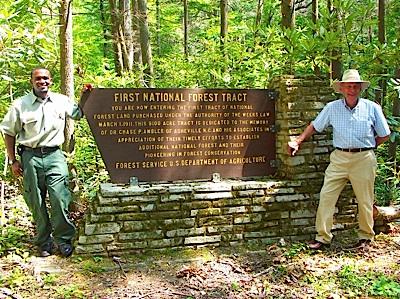The 100th anniversary of the Weeks Act establishing national forests in the East was celebrated on the Blue Ridge Parkway this past Saturday as officials looked out over the first tract of land purchased under the law.
On a warm, beautiful day at Laurel Knob Overlook, Milepost 349.2 (not far from Mount Mitchell State Park), Parkway Superintendent Phil Francis and Pisgah National Forest District Ranger John Crockett of the Grandfather Ranger District unveiled an interpretive easel about the Weeks Act before a group of officials, employees, media, and the public.
The easel pictures the ridges visible below that comprised the Burke/McDowell tract, the first land purchased in the East for Pisgah, the first national forest. The plaque features before and after photos of one parcel, stripped of trees, then reclaimed through Forest Service efforts.
Ranger Crockett profiled the history behind the landmark legislation, carried by Congressman John Wingate Weeks, a Republican from Massachusetts, that was passed in March 1, 1911. The motivation behind the legislation was "to protect the headwaters of rivers and watersheds in the eastern United States and called for fire protection efforts through federal, state, and private cooperation," according to U.S. Forest Service history.
Ranger Crockett contrasted the original 8,000-acre parcel visible below with the 1.2 million acres of land claimed today by the national forests in North Carolina.
The Forest Service ranger Crockett then handed off to Parkway Superintendent Francis, who thanked Marisue Hilliard, supervisor of National Forests in North Carolina, for approaching him with the idea of a Blue Ridge Parkway exhibit.
Superintendent Francis said the event was the perfect opportunity to dwell on the fact that the scenic vistas of the Blue Ridge Parkway are “borrowed” from the beauty of surrounding lands. He said there was actually legislation that requires the Parkway to work with the Forest Service, “to be partners and friends ... well, maybe it doesn't say friends,” he said, getting a laugh from the crowd. “But we are friends, and that’s the good news.”
Superintendent Francis said that the national park experience of the Parkway, and perhaps even the ultimate routing of the road through North Carolina instead of Tennessee, were the result of thousands of spectacular acres of surrounding National Forest land.
Ironically, the first members of the public to read the sign—despite their Harley Davidson and Southern Appalachian motorcycle T-shirts—were Canadians, the Douvilles, from Montreal.
After the unveiling, the group drove past the U.S. Forest Service Curtis Creek Campground, pausing at the 50th anniversary Weeks Act sign dedicated in 1961 by U.S. Forest Service Chief Richard E. McArdle. The tour finished at the Mountain Gateway Museum in Old Fort, North Carolina, where Jim Webb, former Forest Service Associate Deputy Chief, a native of the area, shared his thoughts about the Weeks Act.
The surrounding area’s rich forestry history includes the Cradle of Forestry, south of Asheville, North Carolina, where “forestry education began in 1889.” While building Biltmore Estate in Asheville, George W. Vanderbilt hired Frederick Law Olmsted at whose urging Mr. Vanderbilt hired Gifford Pinchot as forest manager, later the first chief of the Forest Service. German forester Dr. Carl A. Schenck was hired in 1895, and besides teaching the fledgling science of forestry, he managed the estate’s forests, “transforming the woodlands we know today as Pisgah National Forest into a restored image of what was once a flourishing forest.”
Among the dignitaries attending the event Saturday were Randy Flack, regional field representative for Congressman Heath Shuler; Freddie Harrill, western regional liaison for U.S. Sen. Kay Hagan; and Tom Kenney, land protection director for the Foothills Conservancy.
Traveler postscript: For years there had been some competition between New Hampshire and North Carolina as to which state had the first Weeks Act parcel, but, “It’s been established that North Carolina had title to the Burke/McDowell tract two years before lands were acquired in New Hampshire,” Ranger Crockett said. There were a few chuckles when it was noted that there was a Week’s Act ceremony going on in New Hampshire on the same day as the Pisgah event.
Randy Johnson is the author of Hiking the Blue Ridge Parkway and Best Easy Day Hikes Blue Ridge Parkway, the two bestselling trail guides to the most visited unit of the national park system (as well as “Hiking North Carolina” and other books). Visit him at www.randyjohnsonbooks.com


 Support Essential Coverage of Essential Places
Support Essential Coverage of Essential Places







Comments
I'm delighted to read of the new interpretive markers on the Blue Rodge Parkway celebrating the Weeks Act. One edit to your article: The overlook at MM349.2 is called Licklog Ridge. It is a large parking area with panoramic views from Laurel Knob (southwest) across Linville Gorge to Hawksbill and Tablerock Mountains (northeast). It is a spectacular location!
http://www.highcountryparkway.com/parkway-overlooks-and-gaps/high-countr...
Volknitter, in a case of you're right...but you're wrong, it appears the Park Service recently, and without much notice, changed the name of the overlook to Laurel Knob. My guess is they didn't feel the original name was PC...
The Blue Ridge Parkway is one of my favorite places to ride Motorcycle. Beautiful ride!
Not sure why the name of the overlook was changed. The part of the Parkway where the new Weeks easel is located, the NC High Country between Asheville and I-77 in Virginia, is particularly stunning. Check out this complete Parkway guide to that area—
http://www.exploreboonearea.com/BlueRidgeParkway/tabid/230/Default.aspx